Can You Frankenstein A Digital Camera

"Nothing is permanent except change," said the Greek philosopher Heraclitus. Anyone who follows the rapidly evolving digital-imaging world has to hold. Consumer-level digital cameras are becoming always more powerful, small (if you desire), and inexpensive. They have replaced film cameras as the tool of choice for the snapshooting public. But what quality photographs will your digital camera for astrophotography produce?
Digital Photographic camera for Astrophotography vs. Film
Film still surpasses all but the highest-end digital cameras for resolution and color accuracy. And, unlike dedicated astronomical CCD cameras that utilize cooled chips, the sensors in consumer cameras generate objectionable "dissonance" during long exposures, so their useful exposure times are generally limited to a matter of seconds. This is fine for bright subjects such every bit the Moon and planets, but too short for the deep sky — though you tin can beat the problem past taking many short exposures and digitally stacking them. Digital cameras mostly need a computer to manipulate and print images, merely the engineering is evolving apace, and photo printers that work without a computer are now mass-market items.
Advantages of Going Digital
Of form, the advantages of going digital are many. You lot get instant results and can adjust what you lot practise accordingly — no waiting for pictures to come dorsum from the photo lab. You can shoot all y'all want and throw all just the all-time pictures away without worrying nearly film and processing costs. The photographic camera's memory can probably hold many more than images than a coil of film.
 Meade Schmidt-Cassegrain telescope.
Meade Schmidt-Cassegrain telescope. Since the camera's output is already digital, the images are set for computer processing with programs such as Adobe Photoshop, which can correct color imbalances, optimize brightness levels, dynamic range, contrast, and colour saturation, and enhance image quality by stacking exposures. You can create a wide-field mosaic by stitching together adjoining frames. The images are Net-set up — you can e-mail them or share them on the Web. They can be easier to sort and organize and take up less storage infinite than photograph albums or shoeboxes.
Digital cameras are versatile — they can exist used to digitize prints and 35-millimeter slides by recopying them. They can also be coupled a spotting telescopic for wildlife photography. The price of high-resolution cameras is constantly dropping. All these features make a digital camera for astrophotography very bonny for astro imaging. If y'all already accept one, yous should certainly see what it can exercise.
The Afocal Method
A basic, consumer-level digital camera for astrophotography doesn't have removable lenses; you accept to go to a more than expensive digital SLR photographic camera for that. Creating astrophotography with a digital camera in this method means but way to shoot through a telescope with them is by the afocal method, whereby the camera'due south lens is aimed directly into the telescope's eyepiece. You can concur the camera by hand, mount it on a separate tripod, or make or purchase a bracket to attach the camera straight to the telescope. (See our afocal method to larn more than about its history.)
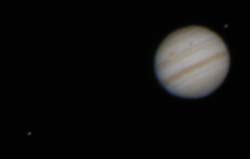
For this view of Jupiter, Io (the dim dot in the lower-left corner), and Europa (upper-right corner), New Jersey amateur Lester Dobos used his Olympus C-2020 camera and xvi-inch Dobsonian with a 9-mm eyepiece. Notation the Slap-up Scarlet Spot and Europa'due south shadow in transit.
Similar the old eyepiece-projection technique, the afocal method dramatically increases the image size at the expense of a much slower constructive f/ratio (or photographic speed). You may also become some vignetting and image distortion. Vignetting is the darkening of an image'southward edges that happens when light is cut off past mechanical limitations. Information technology typically happens when the camera is held too far from the eyepiece or when the credible angular field of the photographic camera's view exceeds that of the eyepiece. This, nonetheless, is normally not a problem when you lot are photographing planets or other small objects that tin be kept centered. To reduce vignetting, set the camera as close to and centered on the eyepiece equally possible. Also, choose an eyepiece with aplenty center relief – some short-focus eyepieces have such limited eye relief that a camera cannot go shut enough to prototype well through them. Find the best camera position by experimentation.
Improving Your Images and Experience
Zooming in narrows the photographic camera for astrophotography's angular field and thus can minimize or eliminate vignetting (just avoid using "digital zoom," which sacrifices 's resolution). Zooming likewise increases magnification, which often makes focusing easier. On the other paw, it makes finding your target tougher.
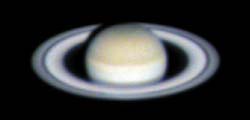
Images from digital cameras tin be improved with popular epitome-editing software such as Adobe Photoshop. This portrait of Saturn was obtained past Hong Kong amateur Catechism Lau with a Nikon Coolpix 950 camera. He used a 14-inch Celestron Schmidt-Cassegrain telescope and a 6.7-mm eyepiece. Colleague Eric Ng digitally stacked nine divide exposures and applied Photoshop'south unsharp mask and Gaussian blur procedures to enhance the final image.
Image distortion can occur due to various effects in the eyepiece and photographic camera optics. The center of the image may exist in focus while the outer areas are not, severely restricting the usable field. Be certain you keep the camera'due south image plane centered on and perpendicular to the telescope'due south optical axis. Also, go on the eyepiece and camera lenses costless from smudges and dust, which degrade contrast.
Mounting the camera on a divide tripod tin prevent vibration while avoiding the need to rebalance the telescope for the camera'southward weight. With such an system, it helps to orient the eyepiece then that information technology moves direct toward or away from the camera as the telescope follows its subject area across the heaven. Utilize a black cloth or cardboard mask to shield the eyepiece and photographic camera lens from stray light.
Although not essential, a telescope motor bulldoze is user-friendly since it keeps the discipline centered in the photographic camera fpr astrophotography's frame equally you lot focus and etch the shot. For scopes without a drive, you lot tin still accept proficient pictures if you lot keep exposures brusque. Position your subject at the edge of your frame opposite the direction of migrate, then wait for the object to glide well-nigh the frame's center before triggering the shutter.
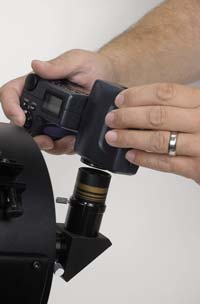
Daring astro imagers can simply hold a digital camera directly over the eyepiece. Alternatively, if your photographic camera has a standard ¼-20 tripod socket, you tin apply a homemade or commercial bracket for support or mount the camera on a separate tripod.
Sky & Telescope / Craig Michael Utter
Focusing Your Camera for Astrophotography
As with motion picture astrophotography, you demand to obtain perfect focus, since whatever errors volition bear witness up prominently. You lot tin can brainstorm by focusing the telescope visually using the eyepiece (if yous employ prescription glasses, wear them) and setting the photographic camera lens to infinity. If the camera for astrophotography doesn't have a manual override, just use its autofocus manner. The built-in LCD screen tin can exist used for centering and focusing, just some people observe it a scrap too minor and coarse to judge the focus precisely.
If your camera has a video output, you can connect information technology to a larger monitor (say a xiii-inch portable TV) to aid you lot adjust the fine focus while watching the Television set screen. This real-time video brandish is too useful when expert seeing is intermittent – y'all tin can use the video to judge the best time to take the images.
Imaging the Sunday through the telescope requires a proper, condom solar filter (click hither for a listing of filter vendors). Be sure to comprehend the front of the camera's viewfinder. Focusing with the LCD screen in bright daylight can be catchy, so shade the screen or employ an external, shaded Television receiver monitor. (Some people attach a loupe to the LCD screen with rubber bands or Velcro for added accuracy when focusing and to assist in viewing the screen in vivid daylight.)

For digital cameras with threaded lens barrels, such as the Nikon Coolpix 990 shown hither, you can purchase diverse lens adapters to attach the photographic camera to the telescope eyepiece. Left: This adapter from ScopeTronix direct mates the 990's 28-mm lens thread to several types of ane¼-inch eyepieces. Right: CKC Power'south 28-mm-to-T adapter couples to Orion'south universal photographic camera adapter.
Sky & Telescope / Craig Michael Utter
As with film astrophotography, a good-quality finder is helpful for aiming the telescope. A larger, higher-power guidescope, if precisely aligned with the main scope, tin can help in getting small-scale targets such as planets into the photographic camera's view.
Taking the Shot
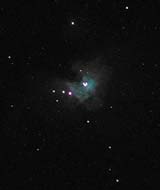
Long exposures are beyond the attain of basic consumer digital cameras; electronic racket starts to appear in exposures longer than a few seconds. Dennis di Cicco took this noisy 8-2nd exposure of the Orion Nebula (M42) with a Nikon Coolpix 990 on a 6-inch f/vi Maksutov-Newtonian telescope with a 30-mm eyepiece.
Unlike single-lens reflex (SLR) cameras, digital point-and-shoots accept no "mirror slap" that can cause vibration when taking a picture. But you can still cause shaking when pressing the shutter. To prevent this, use the camera's self-timer or wireless remote release if it has 1. Otherwise, yous have to press the shutter yourself (very gently!) without shaking the setup. Some people have fashioned homemade brackets to hold the end of an onetime-fashioned cable release over the shutter button.
Many pop cameras have no manual override for choosing exposure (y'all cannot set your own shutter speed and aperture), so you lot take to rely on the autoexposure office. This works best with large, bright, uniformly lit subjects such as close-ups of the Moon. But the camera's lite meter may overexpose or underexpose the crescent Moon or planets, so you demand to manually correct using the camera's exposure-compensation capabilities (unremarkably +2 to —2 stops). Recall to bracket your exposures. Preview the results on the LCD screen, and save the best. Don't be afraid to experiment with exposure compensation — try ane or two stops brighter or darker than normal, and note the settings that come out best.
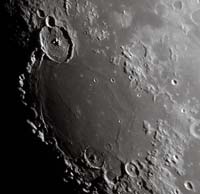
Alan Adler took this snapshot of the 110-km-wide crater Gassendi on the northern edge of the Moon's Mare Humorum using a Nikon Coolpix 950 attached to his viii-inch f/6 Newtonian reflector fitted with a 10.5-millimeter eyepiece.
For the planets, trial and fault is needed to find the correct exposure. A good starting point for Jupiter and Saturn is ¼ to ½ 2d for typical Schmidt-Cassegrain telescopes. Keep exposures short to minimize blurring due to atmospheric turbulence. (The best mod planetary imaging, all the same, is done not by taking single shots with a camera at all, simply by stacking hundreds of video frames taken with a digital webcam.)
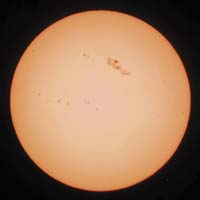
Wiphu Rujopakarn of Kirdkao Observatory in Kanchanaburi, Thailand, imaged this naked-eye sunspot grouping on March 25, 2001, with a Canon IXUS photographic camera through a filtered Tele Vue Pronto refractor and a 32-mm eyepiece.
Employ your camera for astrophotography's highest paradigm-quality setting when saving the paradigm. This means using the camera's total resolution and applying the to the lowest degree image compression. Most popular consumer cameras salvage images using JPEG pinch to reduce file size and get more images into the available memory. The more you compress an image, however, the more it begins to show artifacts such equally degraded color and, when magnified, squarish blotchy patterns: "jpegging." Use the everyman compression possible, or save the image in an uncompressed format such every bit RAW or TIFF if your (high-end) camera for astrophotography allows.
Don't be surprised if you lot tin can store more astronomical than daytime images in the same amount of retention. The dark background of a typical astronomical scene compresses far more than conventional images. You can also experiment with the black-and-white mode if your camera offers this feature. Because of the mode color CCDs work, images shot in black and white can appear sharper than color images.

Dennis di Cicco recorded the April 27, 2001, occultation of 3rd-magnitude Eta Geminorum by the Moon from eastern Massachusetts. For each 4-second exposure he used a Nikon Coolpix 990 on a half dozen-inch f/half dozen Maksutov-Newtonian telescope with a 26-mm eyepiece.
Ability Requirements
Digital cameras are battery eaters, peculiarly if you use the LCD screen continuously. You tin can avoid the trouble if you have an Air-conditioning adapter and access to a wall outlet. Fresh batteries can concluding less than a half hr in some cameras. Also, on cold nights batteries lose their chapters more rapidly. Keeping a supply of fresh alkali metal or lithium batteries can be very expensive, and then the best option is to buy rechargeable nickel—metal hydride (NiMH) batteries. Keep one or 2 spare sets charged and handy for long sessions.
To preclude damage to sensitive electronics, protect the camera for astrophotography from excessive dew. Embrace the camera when non in use, and on dewy nights, continue it powered upwardly to maintain some internal warmth.
Despite their shortcomings for some applications, handy, mass-market digital cameras are here to stay? and are sure to get better. No doubt they will play a growing office in amateur astronomy. Then why not beginning now? Become inspired by looking at some of the greatest astrophotography from amateurs and professionals akin and bask!
Selected Manufacturers and Dealers
Here's a partial list of companies that sell digital-camera accessories that astro imagers will find useful.
- Adirondack Video Astronomy
26 Graves Street
Glens Falls, NY, 12801
518-812-0025
www.astrovid.com - Adorama
42 West 18th Street
New York, NY 10011
212-647-9800
www.adorama.com - BrightStar Optical & Photo
29325 Hwy 178
Onyx, CA 93255
760-378-9999
[email protected] - CKC Power
23 Graywood Dr.
Orangeburg, NY 10962
845-627-1055
www.ckcpower.com - LensPlus
11969 Livona Lane
Redding, CA 96003
800-659-7770
www.lensadapter.com - Oceanside Photo & Telescope
1024 Mission Artery
Oceanside, CA 92054
800-483-6287
world wide web.optcorp.com - Orion Telescopes & Binoculars
P.O. Box 1815
Santa Cruz, CA 95061
800-676-1343
www.telescope.com - Photosolve
21272 Chiquita Fashion
Saratoga, CA 95070-4259
world wide web.photosolve.com - ScopeTronix
1423 SE 10th St., Unit of measurement 1A
Greatcoat Coral, FL 33990
941-945-6763
www.scopetronix.com - Tau Ceti Company
P.O. Box 1101
Conroe, TX 77305
936-539-4073
www.us-astro.com - Tele Vue Optics
32 Elkay Bulldoze
Chester, NY 10918
845-469-4551
www.televue.com
Source: https://skyandtelescope.org/astronomy-resources/astrophotography-with-a-digital-camera/
Posted by: reedvortunfir88.blogspot.com

0 Response to "Can You Frankenstein A Digital Camera"
Post a Comment